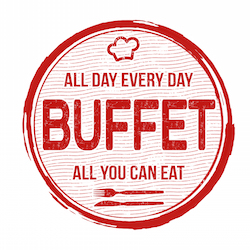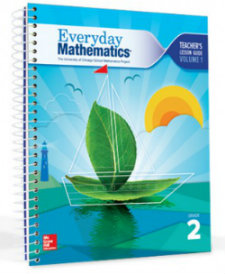The All-You-Can-Eat Math Resources Buffet
A MiddleWeb Blog
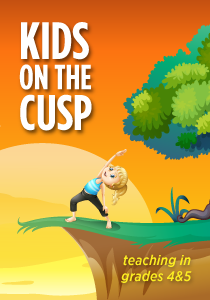
Although he couldn’t verbalize his concern with this new experience, his eyes said it: “What is this, and why are you feeding it to me?”

We have been using Everyday Math for well over a decade. I admit I wasn’t a fan in the very beginning. I was too scared of the newness of it all after having taught with the traditional Addison Wesley textbook and a spiral-bound Teacher’s Edition for several years. Math was familiar and kind of cozy, then. It was a comfort food.
I have always been a math geek, ever since my own days in the advanced math classes in junior high. As a teacher, math has always been dependable. It has always been there to fall back on when a Science experiment went awry or a Social Studies lesson fell flat. It has always been the carving station at the buffet table. Prime.
After a year or two of exposure to the “New Math,” I began to appreciate some of the new flavors available for the tasting. I began to pick and choose what I saw working in my classroom, with each particular group of students.
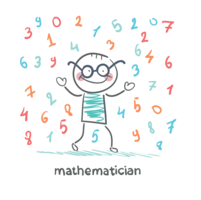
There was very little focus on facts and formula practice in Everyday Math, so I needed to grab my old favorite, Addison Wesley, off the spice rack for some rote memorization of facts and some formula practice sheets. I still use it to this day, as a useful resource. It’s just takes up much less space on my teaching plate.
Things have changed: the New New Math
The “New, New Math” is here, on the table. It is expected that I use it. I am. But I still prefer to choose my fare carefully. I have never negated the benefits of the new math program, I just need to enhance the meal.
Thankfully, my palate has developed over the years. I am more able to identify and discern what tastes good to me (and will go down well with my students), and what is tasteless, lumpy, and flavorless. I use the same approach at the All-You-Can-Eat buffet and come away relatively happy with the experience.
The curriculum buffet in my district is impressive. Within the last four years, we have been offered brand new resources to use in Reading and Literacy, Social Studies, Spelling, and Math. We have been instructed to utilize new website platforms, incorporate technology into instruction, generate endless spreadsheets to collect student data for “analysis,” and still teach. We are lucky in my district to have so many choices (along with some required eating), but there is way too much on the buffet! We can’t do it all at once.
At an All-You-Can-Eat buffet, you don’t have to take some of everything and pile it on your plate. There is an art to All-You-Can-Eat. First, it’s important to preview the spread. I find a lap or two around the chafing dishes gives me an inkling of what I want to choose to start off with.
I am taking this same approach to our new, online Everyday Mathematics program. This summer I had time to attend a three-hour workshop to give us an overview of the program. I’m glad I went. It was only a brief look around our newly set math table, but it was an important beginning.
As a self-confessed technophobe, I must say the current buffet table is full of strange dishes; on-line access to the Teachers Editions and all of the Math Masters, Math Journal pages, presentation slideshows, and game and teaching tools. I left the training workshop not quite knowing where to begin.
What I am looking at on my plate right now, however, is a partially filled-in boiler-plate document. It is the “Student Growth Objective” form I am required to fill out, the rice cereal of my district’s teacher administrative requirements. It’s a math goal this year. I’m going to push it to the side for now. There are tastier things on the table.
What’s working so far
Instead, I am making room on my plate for what seems to be working so far – some new recipes to sample.
The new-found ability to fit in the Math Boxes that accompany each lesson has been quite successful. There is still no time to do them during our blocked “math time,” but two days a week they are the appetizer we experiment with first thing in the morning.
When the kids enter the room on Wednesday and Thursday mornings, the room is dark, the Math Boxes page is projected on the white board, and the closet light is on, helping the gang unpack and start their day in the right frame of mind. It has been working beautifully, but we’ve had to skip a math box or two in order to keep up with the meat and potatoes of each lesson.

My palate is still having trouble with the “presentation” tool. I can see its potential. I can taste the possibilities. I just don’t know it well enough yet to teach it effectively. If it doesn’t enhance my teaching of math concepts and ideas, I need to leave it for another day.
I need to enjoy the newly discovered parts of the program that do enhance my teaching and keep sampling the newer components once I’ve had time to settle into my meal, savor the array of resources that are already filling my first round plate at the buffet, and digest it all for a moment or two.
I’ll go back up to the buffet. I always do.
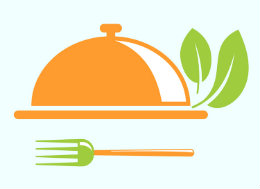
I’m seriously behind in the “planning schedule” of the online component, but the kids are enjoying many aspects of their newly designed 4th grade buffet, and I can taste the possibilities (slightly reminiscent of my first experience with Chicken Tikka Masala, back when I “didn’t like” Indian food).
Chicken Tikka Masala has led me to many other delectable meals. I try to keep an open mind when it comes to sampling new cuisine. Either way, I have no intention of ever eating rice cereal again.
Recipes to Explore:
On-line Math Games, Activities, Videos, and Other Resources
Basic PK – 12 Skills Practice
Routines in Every Day Math: Frames and Arrows
Here’s a video of teacher explaining a great Everyday Math game…she’s adorable! This game is a “go to” in my class as an option when independent work is finished…
Website Resources from Everyday Math (you have to sign up)

